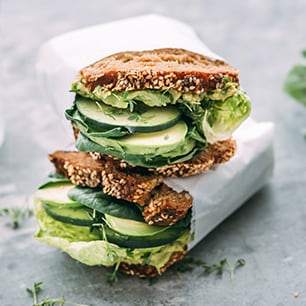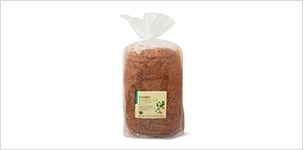September is Whole Grains Month—an opportune time to consider your whole grain intake and identify new sources for this important, nutrient-dense part of our diets. A growing whole grain food trend, sprouted grains are starting to show up in everything from pastas and cereals to pretzels and bagels. You might find them in breads along with other grains such as quinoa or millet, as well as with nuts and seeds, such as flax or chia.1

Kernels of Knowledge About Sprouted Grains
Let’s learn more about sprouted grains—their potential benefits, where to find them, and how to work them into meals.
What are sprouted grains?
Sprouted grains are considered whole grains because they include all the components of the grain (the bran, germ, and endosperm). While there is not a regulated definition of sprouted grains, the American Association of Cereal Chemists International (AACI)—a global, nonprofit association of more than 2,000 scientists and food industry professionals—defines them as follows: “Malted or sprouted grains containing all of the original bran, germ, and endosperm, shall be considered whole grains as long as sprout growth does not exceed kernel length and nutrient values have
not diminished."2
What makes a sprouted grain different?
In just the right temperature and moisture conditions, a grain kernel—the seed of a wheat plant or other grain—begins to sprout. A sprouted grain begins to grow into a new plant, but the new sprout is shorter than the length of the original grain.3
How are sprouted grains used in foods?
Food manufacturers use sprouted grains to make products using two approaches: wet and dry.
To create a wet mash, wet sprouted grains are mashed into a thick puree, which is then used to make breads, tortillas, and other products that may be described as flourless.
To produce a dry flour, grains are sprouted, dried, and cooked like rice or ground into sprouted grain flour and used for baking.3
What are the potential health benefits of sprouted whole grains?
The latest Dietary Guidelines for Americans recommends getting at least half of your grain intake from whole grains, rather than from refined grains. When grains are refined, they lose about 25% of their protein and are greatly reduced in at least 17 key nutrients.4
While there’s no regulated definition of a sprouted grain to allow for an even comparison, growing research suggests that sprouted whole grains may have positive health benefits. The process of sprouting changes the nutritional composition of the grain, making some of the vitamins and minerals (including B vitamins, folate, and vitamin C) and fiber more bioavailable, and increasing
their absorption.4
Also, studies with sprouted brown rice5 and wheat6 show that fiber content increases with sprouting. Keep in mind, however, that these studies have different definitions for sprouted grains.
Shopping for Sprouted Grains
While you shop at Publix, look throughout the store for products with sprouted grains. Here are a few places to find them:
- In our Bakery, check out GreenWise sprouted multigrain bread with organic sprouted wheat
and millet. - In the grocery section, spot sprouted brown rice to serve as a side or in recipes. Sprouted grain cereals are also gaining popularity.
- More sprouted grain breads, bagels, and English muffins are popping up in the frozen foods section.
- When you’re in our Deli, grab some sprouted whole wheat pitas, perfect for sandwiches and snacks.
- Going gluten free? Here’s a sprouted whole grain bread option for you.
- Eating organics? You’ll find that many sprouted grain products are organic, such as sprouted brown rice, Ezekiel sprouted cereal, Alvarado Street breads and bagels, and Food for Life breads.
Meals with Sprouted Grains
Publix has some simple ideas for bringing sprouted grains into your meals and adding nutrient-dense whole grains to your food routine.
Breakfast tips:
- Substitute a hearty sprouted-grain variety for your usual bagel or English muffin.
- Grab breakfast on the go with yogurt, fruit, and sprouted-grain cereal.
- Prepare our Publix Aprons Sprouted Bread-Squash Strata for your family.
Dessert tip:
- Treat yourself and your family to our Publix Aprons Maple Apple-Almond Bread Pudding, with crunchy sweetness and sprouted whole grains.
Explore more tips for getting your recommended 3 to 5 daily servings of whole grains here. Happy Whole Grains Month!
Sources
1 Cernansky, Rachel. "Food trend alert: Sprouted grains." New Hope Network. December 7, 2015.
2 "Definitions of Sprouted Grains." Oldways Whole Grains Council. Accessed June 26, 2018.
3 "Happy Sprouted Grains Month!" Oldways Whole Grains Council. April 9, 2014.
4Lentz, Leesha. "Whole Grains: Sprouted Grains." Today's Dietitian. June 2015.
5 Cácares, PJ, C. Martínez-Villaluenga, and J. Frias. "Assessment on proximate composition, dietary fiber, phytic acid and protein hydrolysis of germinated Ecuadorian brown rice." PubMed.gov. September 2014.
6 Koehler, P., G. Hartmann, and M. Rychlik. "Changes of folates, dietary fiber, and proteins in wheat as affected by germination." PubMed.gov. June 2007.

 You are about to leave publix.com and enter the Instacart site that they operate and control. Publix’s delivery and curbside pickup item prices are higher than item prices in physical store locations. Prices are based on data collected in store and are subject to delays and errors. Fees, tips & taxes may apply. Subject to terms & availability. Publix Liquors orders cannot be combined with grocery delivery. Drink Responsibly. Be 21. For prescription delivery, log in to your pharmacy account by using the Publix Pharmacy app or visiting
You are about to leave publix.com and enter the Instacart site that they operate and control. Publix’s delivery and curbside pickup item prices are higher than item prices in physical store locations. Prices are based on data collected in store and are subject to delays and errors. Fees, tips & taxes may apply. Subject to terms & availability. Publix Liquors orders cannot be combined with grocery delivery. Drink Responsibly. Be 21. For prescription delivery, log in to your pharmacy account by using the Publix Pharmacy app or visiting 
